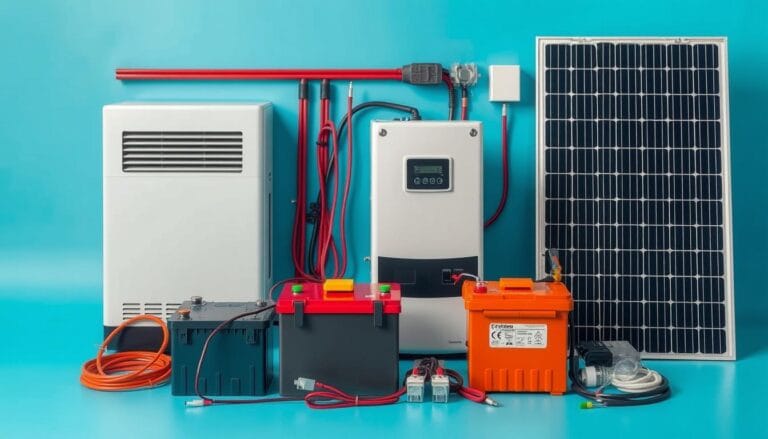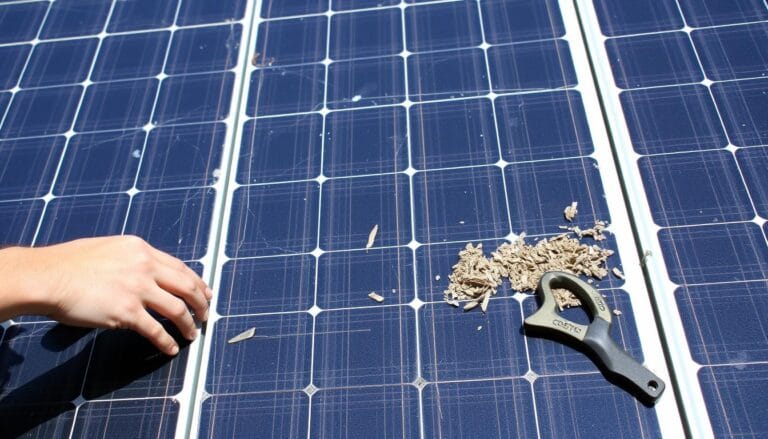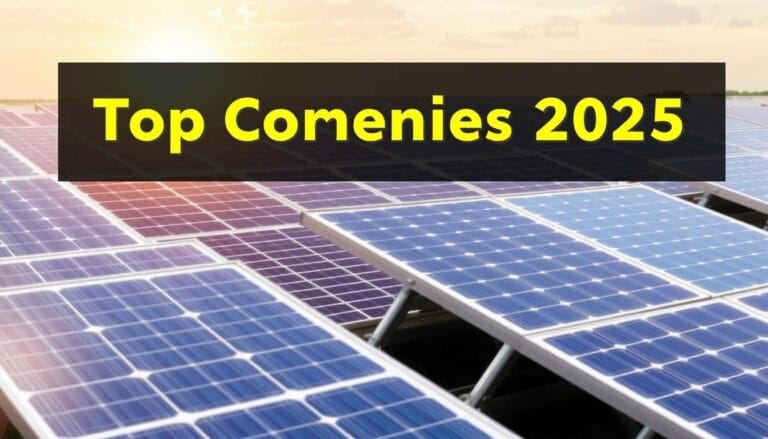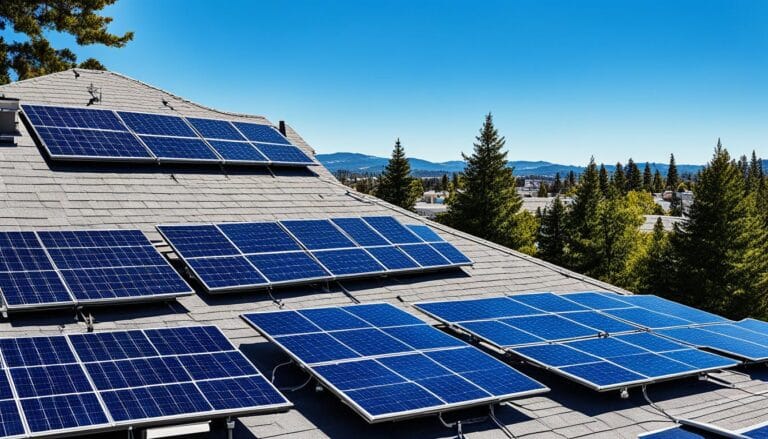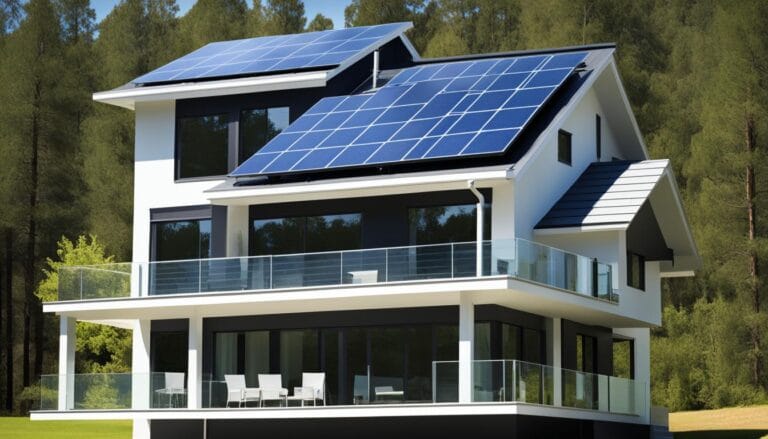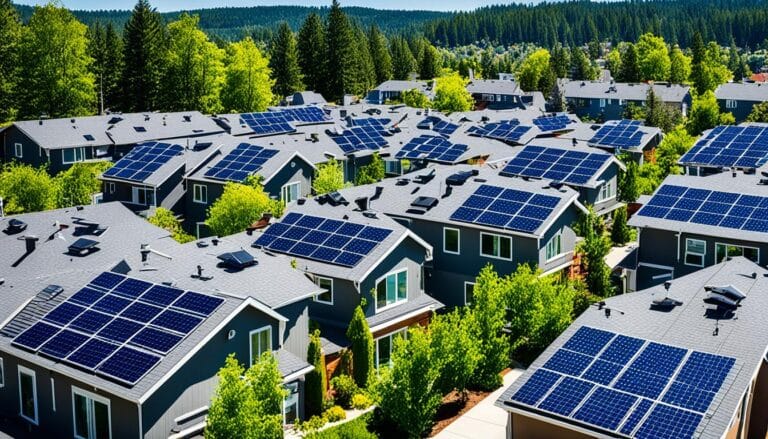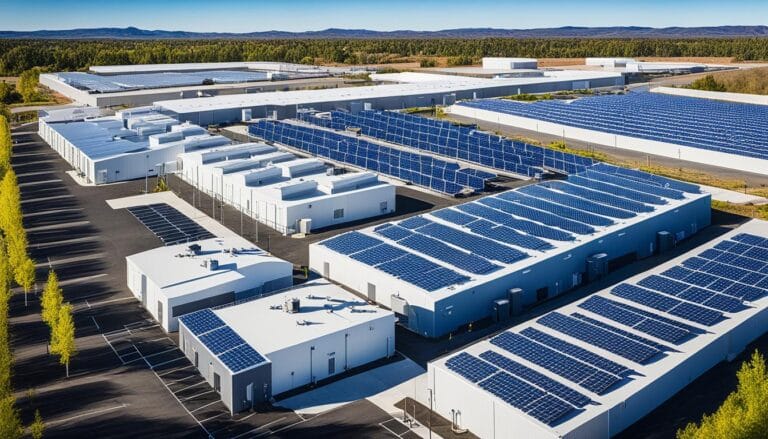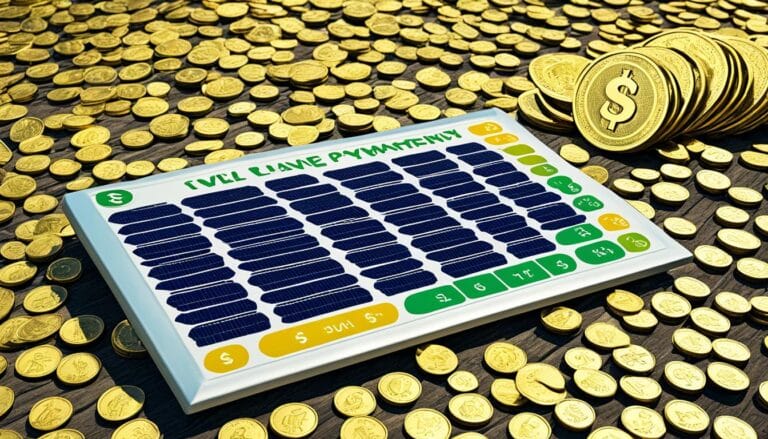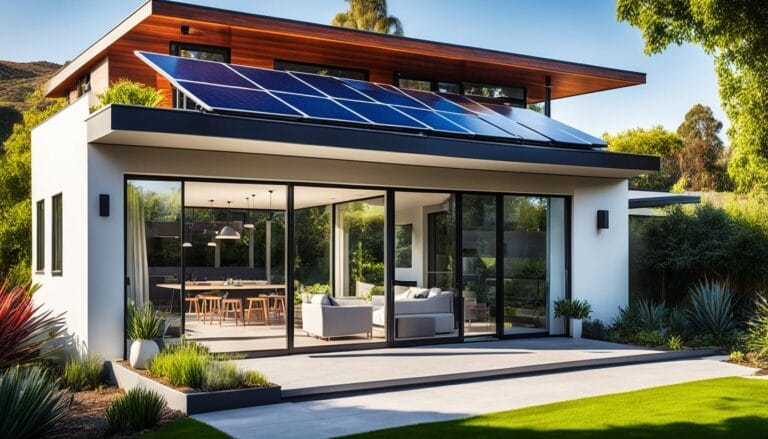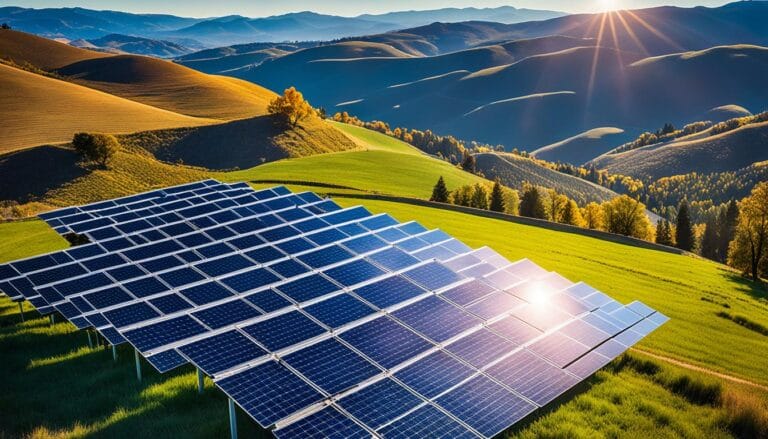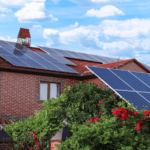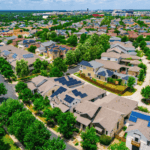Homeowners are now wondering, “Are home solar panels worth it?” A detailed solar panel cost analysis shows both financial and environmental benefits. With just an hour and a half of sunlight, we could meet global energy needs for a year. This makes solar power a smart choice.
Installing solar power systems comes with a high upfront cost. But, technology and market growth have cut prices by over 50% in ten years. The long-term savings and a 30% federal tax credit make solar more affordable. However, the cost and benefits vary by location, roof type, and panel type.
Solar panels are great for the environment too. They’re a renewable energy source, unlike non-renewable fossil fuels. Going solar means less reliance on the grid, a smaller carbon footprint, and higher property values. It’s good for the planet. For more details, check out this guide.
Key Takeaways
- Solar panels can provide significant savings over their approximate 25 to 30-year lifespan.
- Financing options are available to ease the initial installation costs of solar systems.
- The 30% federal tax credit and net metering programs offer substantial financial incentives.
- Solar energy is a renewable, sustainable source that reduces dependency on non-renewable resources.
- While the initial costs may be high, the long-term economic and environmental payoffs warrant consideration.
- Property value increases and reduced utility bills are tangible benefits of solar panel installations.
Understanding Home Solar Power Systems
Home solar panel installation is getting more popular among homeowners. They want to use the sun’s energy as a green power source. Solar panels turn sunlight into electricity using photovoltaic technology. This process creates electrical charges to power homes.
How do Solar Panels Work?
Sunlight hits the solar panels on your roof first. These panels have tiny units called photovoltaic cells, mostly made of silicon. When sunlight hits these cells, it makes electrons move, creating electrical charges.
This DC electricity then changes to AC electricity with an inverter. This AC electricity can power your home’s lights and appliances.
Components of a Home Solar Panel System
A solar power system has more than just panels. It needs several important parts to work well and last long. These parts are:
- Photovoltaic Cells: These turn sunlight into electricity.
- Inverter: Changes DC electricity to AC electricity.
- Battery Storage: Saves extra energy for cloudy days or at night.
- Monitoring System: Tracks how well the solar panels are working.
To learn about the money-saving benefits of solar panels, check out great resources. They talk about federal tax credits and local rebates that lower the cost. In Texas, these incentives make solar power a smart choice, helping the state lead in solar production.
| Component | Description | Function |
|---|---|---|
| Photovoltaic Cells | Silicon-based cells | Convert sunlight to electricity |
| Inverter | Device that converts DC to AC | Allows electricity to power home appliances |
| Battery Storage | System to store electricity | Provides power during non-sunny periods |
| Monitoring System | Tracks performance | Ensures efficient operation and maintenance |
Knowing how solar panels work and their parts helps homeowners make better choices. Using solar power is good for the planet and can save money on bills. It also cuts down on our use of traditional power grids.
The Economic Impacts of Solar Panel Installation
Installing solar panels is a smart move for a greener lifestyle and a good financial choice. Thanks to tech improvements, homeowners see better efficiency and returns on investment from solar energy.
Homeowners can use a solar energy savings calculator to figure out how much they’ll save on bills. Even though the start-up costs are high, they’re offset by long-term savings and higher property values. Plus, you might make money by selling extra energy back to the grid through programs like the Smart Export Guarantee (SEG).
| Financial Aspect | Details | Impact |
|---|---|---|
| Initial Investment | $10,000 – $18,000 | High upfront cost |
| Annual Savings | Up to $915 on energy bills | Reduces monthly expenses |
| Property Value Increase | Consistent rise | Increases resale value |
| ROI | Average about 10% annually | Attractive potential return on investment |
| Maintenance Costs | Low | Reduces long-term financial burden |
Solar panels are a smart choice for homeowners. They make electricity without costing anything and offer a great potential return on investment. With government incentives and better solar panel efficiency, the benefits keep growing.
Adding solar panels to homes is good for the planet and your wallet. It’s a smart move for those looking to switch to renewable energy.
Environmental Benefits of Residential Solar Panels
Using solar panels helps homeowners save on bills and boosts the benefits of solar power. It’s a big step towards a sustainable future. Solar energy is key in cutting down greenhouse gas emissions. This move away from traditional energy sources is good for the planet.
Renewable Energy Source and Sustainability
Solar power is endless and keeps replenishing itself. This makes it a sustainable choice. It greatly helps in reducing greenhouse gas emissions. This means a cleaner environment for future generations.
Switching to solar energy also means using less fossil fuels. It meets global sustainability goals. For more info on top solar panels, check out this resource.
Reduction in Carbon Footprint
Solar panels are key in lowering greenhouse gases linked to traditional power sources. These sources often burn coal and natural gas. This big cut in carbon emissions comes from using solar energy, which doesn’t pollute.
Every home with solar panels helps in saving the environment. Here are some key facts about solar panels:
| Statistic | Details |
|---|---|
| Longevity of Solar Panels | Typically last 25-30 years |
| Property Value Impact | Homes with solar panels sell for 4% higher |
| Break-even Period | 6-10 years |
| Cost for Professional Service | $140 to $180 |
| Annual Maintenance Cost | Approximately $150 |
| Cost of Solar Batteries | $200 to $14,000, depending on type |
| Emission Payback | 1-4 years for solar panels to offset greenhouse gases |
| Federal Solar Tax Credit | 30% of the cost of the solar system |
Overall, solar power brings many benefits. It’s a smart choice for a sustainable future and helps reduce greenhouse gas emissions.
Initial and Long-term Solar Panel Cost Analysis
Switching to solar power means understanding both the upfront and ongoing costs. It’s key to look at the home solar panel installation costs. We need to think about what affects the average upfront cost and the costs over time.
Average Upfront Costs Across the United States
The cost to install solar panels changes a lot by location, panel type, and installation fees. Studies show the average upfront cost for a 6-kilowatt system is between $20,548 and $30,666. The panel type is a big factor, with monocrystalline panels costing $2.30 to $3.82 per watt. Polycrystalline panels are cheaper, at $0.90 to $1.50 per watt.
Solar panel cost analysis shows size and type affect the initial cost for homeowners.
Understanding Long-term Maintenance and Operation Costs
Long-term costs for solar panels are important too. Luckily, these costs are usually low. Solar systems are built to last with little upkeep. You might need to clean them and check them now and then to keep them working well.
Most costs are in the beginning, making these systems a good investment for the future.
“Are Home Solar Panels Worth It?”: Calculating the Return on Investment
Thinking about switching to solar energy? It’s key to look at the solar panel return on investment for homeowners. Things like system size, energy efficiency, and local electricity rates matter a lot. Plus, financial incentives and rebates make it more appealing.
Solar energy savings calculator tools are super helpful. They give you specific info based on where you live, your roof size, and how much electricity you use. This helps figure out your savings and how long it’ll take to pay back.
For example, a 7 kW home solar system in 2023 costs between $19,950 and $21,000 before incentives. But, with a 25-year lifespan and little upkeep, the savings add up. After the 30% federal tax credit, the cost drops to about $13,965 to $14,700. This makes solar more within reach.
| Cost Description | Amount | After Tax Credit |
|---|---|---|
| Initial Cost (7 kW System) | $20,475 (average) | $14,332.50 |
| Annual Maintenance Cost | $300 (average) | $300 |
The payback period is about seven years, with a return of investment around 14%. This looks good, given solar panels come with warranties for at least 80% performance after 25 years.
Looking at DIY solar setups versus professional ones, there’s a lot to consider. This guide to DIY solar power gives great advice. It helps you pick the right parts and install them right to save money and boost efficiency.
Homeowners also see higher property values and less environmental harm as big pluses of solar power. In places like Florida, with lots of sun, the benefits are even bigger. So, solar panels are a smart and economical choice.
Advantages and Disadvantages of Solar Energy Systems
Looking at the pros and cons of solar panels and the benefits of solar power gives a clear view. It’s key for homeowners thinking about solar technology. This part talks about the big ups and downs of using solar energy.
Pros of Home Solar Panel Installation
Putting solar panels on your home changes the game for the planet and your wallet. Your home could sell for 4% more because of them. You’ll save a lot of money over 25 years, from $25,000 to over $110,000.
This is because you’ll have fixed electricity costs for a long time. You can also make money by selling extra power back to the grid.
- Substantial increase in home resale value
- Long-term savings on energy costs
- Reduction in carbon footprint, aligning with sustainability goals
- Net metering benefits allow homeowners to earn credits for excess power generated
There’s also a big bonus from the federal solar tax credit. It gives you 30% off the cost of equipment and setup. This makes solar energy more affordable upfront.
Cons of Transitioning to Solar Energy
But, there are downsides to consider. Solar systems can cost a lot, between $25,000 and $35,000. Not every house is right for solar panels. Things like roof condition and sunlight affect how well they work.
Solar panels need sunlight to work and don’t make power at night. This is something to think about.
- High upfront installation costs
- Dependency on suitable roof conditions and sunlight exposure
- Potential presence of toxic materials like lead and cadmium in older panels
| Aspect | Benefit | Drawback |
|---|---|---|
| Cost Efficiency | Savings of $25,000 to $110,000 over 25 years | Initial setup cost ranging from $25,000 to $35,000 |
| Home Value | Increases home value by about 4% | Requires suitable roofing and sunlight |
| Energy Independence | Locks in electricity costs for 25+ years | Does not produce power at night |
| Environmental Impact | Significantly reduces carbon footprint | Toxic elements in some older models |
In summary, the benefits of solar power are strong, offering both money savings and helping the environment. But, the pros and cons of solar panels should be weighed carefully. This helps homeowners make choices that fit their needs and values.
Solar Energy Savings Calculator: Estimating Your Potential Savings
The solar panel cost analysis and the solar energy savings calculator are key for homeowners thinking about solar energy. These tools show how much you can save by looking at your home and local costs.
By entering details like roof size, energy use, and shade, homeowners can see how much solar panels will cost and save. Solar panel prices have dropped a lot, making them more affordable. Now, after incentives, the average cost is much lower.
| Cost Factor | Pre-Incentive Costs (USD) | Post-Incentive Costs (USD) | Annual Savings (USD) | Projected 25-Year Savings (USD) |
|---|---|---|---|---|
| 6-8 kW System (Average) | 17,500 | 11,045 | 1,225 | 30,625 |
| Installation and Equipment | 31,558 | 22,090 | 1,500 | 37,500 |
This solar panel cost analysis is very important. With electricity prices going up by about 2.5% a year, solar panels can help you save money. Plus, you can get tax cuts that can lower the cost by 30%.
Solar panels last for 25 years, which means big savings over time. The solar energy savings calculator helps you figure out these savings. This makes choosing solar energy a smart financial move.
Tax Credits and Incentives for Solar Power Adoption
Investing in solar power is now more financially smart than ever, thanks to tax credits and incentives. These incentives can cut the cost of solar installations by a lot. For example, the federal solar investment tax credit (ITC) can reduce costs by 30%. In California, programs like DAC-SASH offer $3 per watt, making solar energy more affordable for some communities.
California is a leader in solar production, making about 29% of the U.S.’s solar energy. The SGIP rebate of $0.15 per watt-hour for batteries adds to the appeal of solar power. These efforts aim to make solar energy more popular, especially in California.
Federal Solar Investment Tax Credit (ITC)
The federal solar tax credit, or Investment Tax Credit (ITC), helps homeowners with solar installations. It offers a 30% tax reduction on the costs. California residents also get state-specific benefits, like not paying property taxes on the increased home value from solar.
This tax credit will change over time, decreasing from 30% in 2022 to phasing out by 2035. Homeowners should act soon to get the most benefits from these incentives.
State and Local Incentives for Residential Solar
State and local incentives can significantly reduce the cost of solar power. In California, there are many incentives, including net metering and rebates for solar batteries. Local areas like San Diego offer more savings and rebates, showing the state’s commitment to green energy.
Homeowners should check what incentives are available in their area. These can add to the savings from the federal tax credit, making solar more attractive. This support for solar not only helps homeowners but also benefits the environment.








